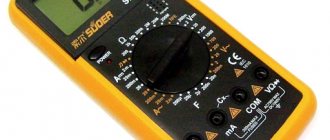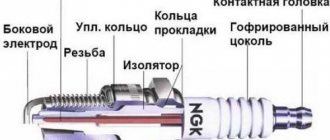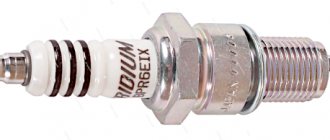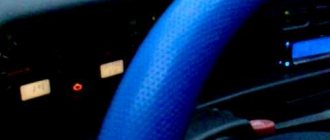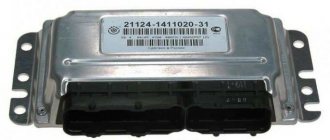Good afternoon everyone. First, a little introductory information about why there is a canbus on a car. Previously, all blocks communicated with each other not only analogue and digitally. But over time, technology becomes smarter. And both the speed and volume of transmitted data are growing. This is the reason for the use of canbuses for the operation of automotive systems. Physically, two wires can supply information at speeds of up to 1,000,000 bits. Which is pretty fast. The machines currently on the market use baud rates of 100,000, 125,000, 250,000, 500,000, 1,000,000 bits per second. Due to this, a large amount of information can be transmitted at a good speed. More advanced models already have 2 or more channel buses.
Misfires in cylinders 1 and 4, VAZ-21093i 2003.
#1 Firiat
- Users
- 4 messages
- Car make: VAZ-21093i
- From: Moscow
Hi everybody.
I’ll immediately write down the full situation of what’s happening with the car. VAZ-21093i, 2003, mileage is approximately 300,000 km (the speedometer does not work, so approximately). I bought it not long ago (about 1 year ago). Initially, everything was good and wonderful, I drove about 150,000 km on it, but not so long ago the engine began to act weird.
At first, the BC gave an error of misfire in cylinders 2 and 3 when the car was moving along the highway when trying to drive in 5th gear, in 4th - no errors. BC cleared the errors and moved on. Well, I drove like that for a while. Then such an error began to occur in the city, the reset did not help. The engine was running rough, wouldn't pull and stalled. As a result, I came to the service and they said that I needed to change:
1. Ignition module 2. Spark plugs 3. High-voltage wires.
I changed it, everything remained at the same level, i.e. the problem has not been resolved.
We looked, smelled, removed the head, changed all the gaskets (I already asked for this, because since 2003 they have never changed, and the car has covered about 300,000 km). When they removed the head, they replaced one valve that had burned out. They said that the cylinders and other valves are good and do not need to be changed. They measured the compression, I don’t remember the readings, but they said it was excellent.
BUT! The "errors" remain. In the end, we came to the conclusion that these were injectors (they were also original). The injectors were changed, the machine started working like a clock, there were no errors, the engine pulled well and flew straight.
A week after the repair, I noticed that the engine began to shake when the fan was turned on. I went to the service center, listened, and the bastard was working fine, they said everything was fine.
He seemed to have calmed down. Now this problem has arisen.
1. In the morning it is difficult to start - the engine is not running stably, chek pops up, the BC shows misfires in cylinders 1 and 4. I reset the errors on the BC, the engine runs well for 10 seconds, then it stops again and again shows a misfire in cylinders 1 and 4.
2. When t.motor is reached. 40-50 degrees the engine is running normally, there are no errors, you can drive.
3. When the engine is fully warmed up, it sometimes feels weird.
I'll go back to the service center on Saturday. I don’t know what they will say. If anyone has encountered something similar, please share your opinion. If you have questions, ask, I will answer if possible, if I know.
What was replaced in the car from the ignition system:
1. Ignition module. 2. Candles. 3. BB wires - new (installed yesterday) 4. Idle speed sensor. 5. TPS.
PS: I respect every opinion, but keep the “buy yourself a new car” opinion to yourself. I won’t buy it, there’s no such option.
To be honest, I googled the internet. It feels like my brain was raped.
#2 yansnow
- Car make: VAZ 2115
- From: Belgorod
Hi everybody. I’ll immediately write down the full situation of what’s happening with the car. VAZ-21093i, 2003, mileage is approximately 300,000 km (the speedometer does not work, so approximately).
I bought it not long ago (about 1 year ago). Initially, everything was good and wonderful, I drove about 150,000 km on it, but not so long ago the engine began to act weird.
At first, the BC gave an error of misfire in cylinders 2 and 3 when the car was moving along the highway when trying to drive in 5th gear, in 4th - no errors. BC cleared the errors and moved on. Well, I drove like that for a while. Then such an error began to occur in the city, the reset did not help. The engine was running rough, wouldn't pull and stalled. As a result, I came to the service and they said that I needed to change:
1. Ignition module 2. Spark plugs 3. High-voltage wires.
I changed it, everything remained at the same level, i.e. the problem has not been resolved.
We looked, smelled, removed the head, changed all the gaskets (I already asked for this, because since 2003 they have never changed, and the car has covered about 300,000 km). When they removed the head, they replaced one valve that had burned out. They said that the cylinders and other valves are good and do not need to be changed. They measured the compression, I don’t remember the readings, but they said it was excellent.
Checking the mass air flow sensor
Before you start experimenting, take the time to read the service manual. It describes in detail what a mass air flow sensor on a VAZ 2114 is and how to replace it.
We are looking for a sensor. Open the hood and find the air filter pipe. The mass air flow sensor is located on it, which determines the flow of air passing through the filter. I will give several options on how to check the mass air flow sensor yourself.
- Disable the sensor. Disconnect the block with wires from the connector by pressing the latch located below. Start the engine (1500 rpm or more). The controller understands the shutdown of the mass air flow sensor as an emergency condition and prepares the fuel-air mixture based on the position of the throttle valve. Try driving a short distance. If the car accelerates noticeably faster, this indicates a non-working mass air flow sensor. I would like to note that in the disabled state for ECUs Y7.2 and M7.9.7. RPM doesn't increase!
- Replacing the controller firmware. The original ECU firmware could have been replaced with an alternative one. In such a situation, we do not know which algorithm is prescribed in the case of operation in the mode discussed in the first paragraph. The throttle valve has a stop under which you need to place a thin plate (about 1 mm) to raise the speed. Then you need to disconnect the chip with the sensor. If the sensor is faulty, the engine should stall. If the engine is running, then the reason is due to the firmware features: the IAC steps are written incorrectly.
- Voltage measurement. Testing gives good results when working with Bosch sensors. You will need a multimeter. Select the DC voltage measurement mode and set the maximum value to 2 V.
The connection diagram for the VAZ 2114 looks like this:
- yellow – incoming signal;
- gray with white – power output;
- green – grounding;
- pink with black – output to the main relay.
The colors may be different, but the sequence of connectors is the same.
Next, you need to turn on the ignition with the engine off. Connect the red (positive) probe of the tester to the yellow output, and the black (negative) probe to the green. Multimeter probes are inserted along the specified wires directly through the rubber seals of the connectors without damaging the insulation. For prevention, I recommend moistening the probes with WD-40. Intermediates or needles are not recommended due to the additional error they introduce. Measure the voltage. Compare the result with the table:
| Voltage, V | State |
| 1,01 – 1,02 | Good. The sensor is almost new and will last a long time. |
| 1,02 – 1,03 | Satisfactory. The sensor is old, but works properly. |
| 1,03 – 1,04 | Bad. The resource is almost exhausted. Will have to replace it soon. |
| 1,04 – 1,05 | Deplorable. The resource has been exhausted. Suitable for use if there are no alarming symptoms. It is advisable to replace |
| 1.05 – and above | Emergency. The sensor is faulty (possibly for a long time). Replacement is required. |
A newly installed sensor gives an output voltage of 0.996–1.01 V. Over time, it increases. A higher value means a higher percentage of wear.
Voltage data from the sensors is recorded by the on-board computer and can be viewed by selecting the appropriate group of parameters.
- Inspection and cleaning. Use a Phillips screwdriver to loosen the clamp holding the air intake pipe. We remove the corrugation and check whether there are traces of oil and/or condensation inside it, as well as on the inner surface of the sensor. Normally they shouldn't be there. The sensing element of the mass air flow sensor often breaks due to dirt getting on it. This can easily be avoided by regularly replacing the air filter. Reasons for oil getting into the air flow sensor:
- the permissible oil level in the crankcase has been exceeded
- The oil separator of the ventilation system is clogged
The sensor is attached to the pipe with two screws. We unscrew them with an open-end wrench (x10) and remove the sensor itself. There is an entrance at the front, which must be protected from the leakage of untreated air with an o-ring rubber seal. If it is missing or remains in the filter housing, dust clogs the sensor input grid. It needs to be cleaned, the seal installed, the leaks checked and the sensor put back in.
- Comparison with a working sensor. From personal experience, I was convinced that the most accurate test is to install a sensor that is known to work and compare the behavior of the engine with the “native” one.
In addition to the options considered for how to check the mass air flow sensor yourself, you can also contact a service center that has special equipment and carry out 100% diagnostics, for example, using the method of evaluating an oscillogram.
Why do misfires occur in the VAZ 2114 cylinders?
There are probably no drivers, especially those with extensive driving experience, who are unaware of such a problem as misfire in cylinders 1 and 4 of the VAZ 2114. This is expressed in the fact that the car jerks and cannot move. In a word, a very unpleasant problem.
Previously, all units had 4 cylinders, and if problems arose with one, then the engine, as they said, began to “triple” and function on 3 cylinders.
VAZ car cylinder block
Nowadays, the situation is somewhat different because the units produced today can even have twelve cylinders. Of course, the phrase “troubling the engine” is no longer relevant, but it still remains and is mentioned when the operation of one of the cylinders is disrupted.
Checking the ignition system elements
Misfires in engine operation, especially in wet weather, are a consequence of breakdown of the insulation of high-voltage wires. There should be no cracks or damage in the wire insulation. You can check the insulation for breakdown using a wire connected to ground. If you run it along the insulation while the engine is running, a spark will be observed in places with damaged insulation. Another clear sign of poor insulation is noticeable electric shocks when touching high-voltage wires while the motor is running.
A broken high-voltage wire can be easily determined with an ohmmeter. The resistance should be between 3-10 kOhm. The spread of indicators between the wires should be no more than 1-2 kOhm.
What causes misfires
The occurrence of misfires on a VAZ 2114 is a real problem that can become a prerequisite for more serious consequences. The car not only jerks, jumps and cannot work at full power. But it also starts with great difficulty; when driving, characteristic popping noises are heard, which occur due to detonation of the combustible mixture in the problem cylinder.
Checking the operation of the cylinders on a VAZ 2114 using computer diagnostics helps to detect many errors. If error P0301 lights up, then this indicates problems in the first one, if P0302 means misfires were detected in the second one.
Code 0302 - errors in the second cylinder
The VAZ 2114 electronic control unit continuously monitors the operation of the power unit through sensors. In this case, the rotation speed of the sensor on the crankshaft and the cylinders involved in a certain period of time is estimated. When a misfire occurs, the crankshaft rotation speed slows down slightly and this is determined by the computer. Modern electronics, if a miss is detected and the specified interval is exceeded, turns off the problematic cylinder. It simply will not receive fuel.
The cylinder can be turned on after a certain time, or after the engine is restarted. No more than 2 cylinders can be turned off at the same time. This is enough to get to the service station and keep the catalyst intact. On early versions of controllers, errors very often occurred when misfires were detected when driving on a bad road. However, now on the VAZ 2114 this problem has been completely solved after installing a road quality sensor.
VAZ 2114 car engine
The difficulty in identifying this malfunction lies in the fact that the misfire is not constant, but appears periodically. It often happens that in cold weather (until the engine is warmed up) it “troubles”, but after warming up, it starts working normally. This occurs due to wear of the cylinders, because after warming up, the metal parts expand and compression is restored.
Checking the ignition coil
The coil is checked based on two indicators: the presence of a short circuit and an open circuit. Before diagnostics, the ignition coil must be disconnected. After this, one probe of the device is connected to the central contact of the coil, the second to the body (ground). If the display shows resistance equal to infinity, there is no short circuit.
The primary winding of the coil for a break occurs differently. The probes of the device must be connected to the right and left contacts. The resistance between them should be within 3-3.5 Ohms.
If the resistance of the primary winding does not correspond to the norm or there is a short circuit in the coil to the housing, it must be replaced.
Fault diagnosis
The ignition of a VAZ 2114 is diagnosed according to the following scheme: the power plant check light lights up on the panel; during testing, error P0300 may light up. This means:
- problems in the first - P0301;
- problems in the second - P0302;
- problems in the third - P0303;
- problems in the fourth - P0304, etc.
Error code 0304 - error in the fourth
There are many factors that cause the air-fuel mixture to not ignite, and they are different.
OPERATIONAL CHECK
Checking the mass air flow sensor does not require a trip to a service station; if you have a multimeter and an hour of free time, you can do it yourself.
FEATURES OF CHECKING THE MAF WITH A MULTIMETER
Checking the VAZ 2114 mass air flow sensor with a multimeter requires knowledge of the pinout of its contacts, which you can see in the image below.
Figure 1.1: MAF pinout
- Contact No. 5 (in Bosch sensors, as a rule, yellow wires come from it) – is responsible for supplying an incoming signal from the ECU;
- Contact No. 4 (gray or white) – is responsible for powering the device;
- Contact No. 3 (green wire) – is responsible for grounding;
- Contact No. 2 (pink-black) is the wire through which information from the sensor is transmitted to the main relay of the fourteenth.
Next, take the multimeter and switch it to DC measurement mode. It is necessary to set the maximum measurement limit to 2 Volts. The check is performed using the following algorithm:
- We connect the red electrode (-) of the multimeter to contact No. 5, the black electrode (+) to contact No. 3. Thin electrodes of the tester must be inserted under the rubber contact seals so that they do not damage the protective coating;
- Turn on the car ignition (do not start the engine);
- We look at the multimeter readings.
Rice. 1.2: Correct connection of multimeter probes
| Tester readings (voltage, V) | Air flow sensor condition |
| 0.006 – 1.01 | Only new sensors produce this voltage; after several weeks of operation it increases by several hundredths; |
| 1.01 – 1.02 | Normal operating voltage of a device in constant operation; |
| 1.03 – 1.04 | The device has used up approximately half of its working resource; |
| 1.04 – 1.05 | The MAF voltage is in an extremely worn condition, replacement is recommended; |
| Above 1.05 | Such a sensor does not work, or it works but sends distorted signals to the ECU. |
HOW TO CHECK THE OPERATION OF THE MAF WITHOUT A MULTIMETER
If, due to the lack of a tester, you cannot check the device using the method described above, there is only one test option left - remove the air flow sensor and see how the car behaves without it.
Dismantle the device or simply turn off the power going to it, start the engine and crank it at 1500 rpm. Start moving. In this case, the ECU puts the fourteenth into emergency mode, in which the fuel mixture is supplied based on the current throttle opening angle.
If, when driving without a mass air flow sensor, you felt that the car literally came to life - it began to pick up speed better when accelerating, problems at idle disappeared, most likely the air flow sensor on the VAZ 2114 is faulty and needs to be changed.
However, a situation is possible in which the cause of the problem is not a failed mass air flow sensor, but incorrect firmware of the ECU itself.
The likelihood of this increases if you took the fourteenth from your hands, since previous owners often do not bother to mention their experiments with the electronic controller.
To check the accuracy of the IAC (idle air regulator) and mass flow sensor control algorithm specified in the ECU firmware, it is necessary to install a spacer in the throttle valve, this is necessary to increase engine speed. A thin metal plate no more than 2 mm thick can be used as a spacer.
Basic faults
Due to the extensive accumulated experience in repairing this malfunction, we can identify common factors that are inherent to any units. Common reasons that can lead to misfires in the ignition system:
- First of all, the problem may lie in the candles. Increased or decreased clearance, carbon deposits. Low quality candles.
Candle with soot
Compression dropped
These are the main factors that are most common.
On cars without a computer, checking and identifying the cause occurs by trying different options.
Once the cause is identified, we move on to repairs. For these works you will need the help of a specialist.
Signs of breakdown
When the ignition is turned on, the engine ECU malfunction indicator light comes on, and after the engine is started, it should go out. A burning warning light is the first sign of problems with the ignition system. Other prerequisites for diagnosing the ignition module are “floating” engine speed and problems with starting. The cause of such failures may be faulty high-voltage wires or spark plugs, so you need to make sure they are working before you start diagnosing the ignition of the VAZ 2107 (injector). Often, cylinder misfires occur due to compression problems or damage to the intake manifold gasket. This must be taken into account when searching for the causes of engine failure.
Misfires in cylinders 2 and 4 on a VAZ 2114
Among experienced car owners, there are only a few who have never encountered such a phenomenon as cylinder misfires. In practice, it looks like this: the car starts to twitch, but does not move. As you understand, there is little pleasure in this.
Previously, all engines included four cylinders. When one of them failed, the engine began to fail. That is, the engine worked only on three and four cylinders.
Today there are up to 12 cylinders on passenger cars. At the same time, the phrase “troubles the engine” still remains relevant and has firmly entered into the everyday life of drivers.
How does the VAZ 2114 mass air flow sensor work?
A modern mass air flow sensor (also known as MAF in English) uses sensitive sensors and a special calculation algorithm to compare the resistance readings of two thermistors. One of them is a reference value, its value is constant. The second (made of platinum-iridium wire) is forcibly heated. The incoming air flow cools the wire, the resistance changes, and to equalize it with the reference, a larger heating current is required. It is the difference in current strength (in this design, voltage is measured using the Ohm's Law formula) that provides information to the ECU.
The measurement accuracy is 1/100 volt, so the slightest malfunction of the mass air flow sensor instantly affects the quality of engine operation.
Important nuances
Floating speed
It will be difficult to start the car, and over and over again the detonation pops of the air-fuel mixture will occur in the idle cylinder.
- Cylinders can be checked using computer diagnostics. This method produces the corresponding errors in the form of codes. Using them it is already easy to determine which cylinder has problems. For example, if there is a misfire in cylinder 2 on a VAZ 2114, then the error code will look like P0302.
- The electronic control unit, that is, the ECU, regularly monitors the operation of the power unit using the appropriate sensors installed on the VAZ 2114. In the case of misfires, the ECU estimates the rotation speed using the crankshaft sensor. If there is a misfire in cylinder 4 on a VAZ 2114, at a certain moment the crankshaft will rotate more slowly, which will be determined by the computer.
- Modern electronics make it possible to automatically turn off a cylinder that has problems. In other words, the fuel supply to it stops.
- The cylinder may return to operation after some time, or after the engine is restarted.
- No more than two cylinders can be switched off at the same time. For your “fourteenth” model, two cylinders are enough to get to the garage or the nearest service station, thereby keeping the catalyst intact.
- In early versions of the VAZ 2114, the electronics generated errors about omissions if the car was moving on bad roads. On updated versions, this problem was eliminated by installing a road surface quality sensor.
- Misfires are not always easy to determine, since this phenomenon is not constant and can occur periodically on the VAZ 2114.
- Car owners often make mistakes in winter, when the engine starts to throttle when warming up, and then, when warmed up, it works normally. This phenomenon occurs due to wear on the cylinders, since when warmed up the metal elements expand and the system returns to normal operation.
- If the VAZ 2114 engine runs normally at idle, but when the load increases, it starts to stall or operate unstably, the cause should be sought in a burnt gasket. Because of this, pressure increases inside the combustion chamber and a leak occurs.
- When the engine coughs a little, but soon returns to normal operation, it becomes difficult to determine the cause. This will require a full diagnosis.
Symptoms of a problem
A mixture misfire is a failure to ignite the fuel-air mixture or its untimely ignition. In any of the cases, the system counts the number of misses and delays, and, if necessary, turns off the idle cylinder or even a pair. On most cars, the first sign of a malfunction is the “check” symbol lighting up on the dashboard.
Also among the common signs can be noted:
- Smell of fuel from the exhaust pipe . Since the mixture did not ignite in the cylinder, it is discharged almost unchanged or partially neutralized.
- Shoots in the exhaust system . If a partial fire occurs, the catalytic converter is severely damaged, which can lead to popping noises.
- Loss of power . The engine does not work properly, causing the crankshaft to spin at a lower speed, resulting in a significant loss of power.
- Engine tripping . Failure of one or a pair of cylinders leads to the fact that the engine begins to vibrate during operation and other signs of malfunction appear.
In cars with an electronic control unit, there are several types of errors that indicate a breakdown.
- P0300 . It is a sign of multiple failures in the process of ignition of the combustible mixture in different cylinders.
- P0301 - p0304 . The last number shows which cylinder is not working properly.
Troubleshooting
The task of diagnostics for misfires is to determine which cylinder on your VAZ 2114 has problems.
Main causes of misfires
First of all, your light comes on, signaling the need to check the engine. During diagnostics, an error lights up - P0300 .
The table provides information regarding which error code corresponds to problems in a particular cylinder.
| Cylinder number | Error code | Where is the pass |
| №1 | P0301 | Problems with the first cylinder |
| №2 | P0302 | Problems with the second cylinder |
| №3 | P0303 | Problems with the third cylinder |
| №4 | P0304 | Problems with the fourth cylinder |
Causes of malfunction
Common to most domestic cars, the reason why the VAZ 2114 air flow sensor breaks is hidden in the crankcase ventilation system. It has two circuits that ensure operation with the throttle valve open or closed. If the throttle is buried, crankcase gases are discharged along the line (d=1.5 mm) into the space available behind it. A certain percentage of these gases accumulates in the idle line, where it comes into contact with the film-coated MAF resistor. It is also sensitive to fluctuations in the gas mixture in the intake system. The resin settles on the surface of the resistor, and the sensor begins to “lie.” Because of this, the idle air control sticks, and it begins to jam when starting the engine.
Common faults
Diagnostic program
There are several reasons why the phenomenon of misfires in the ignition system occurs on the VAZ 2114.
- Problem candles. If carbon deposits appear on them, the gap decreases or increases, they will not be able to work properly. As a result, there are misfires in the cylinders. Quite often, spark plugs do not work for the simple reason that the car owner decided to save money and buy spark plugs of dubious quality. You should not count on their long service life and reliable operation.
- Wiring problems. Here you most often have to deal with wire wear, chafing, and mechanical damage. Sometimes the problem is solved by replacing the wiring. But in some cases, wiring can negatively affect the functionality of the devices it goes to. As a result, both the wiring and the device must be replaced.
- Contacts. Contacts may burn out, become covered in oil, or rust. Cleaning them or completely replacing them may help. The second option is preferable in order to reduce the risk of omissions occurring after a short period of time.
- Damage to the ignition coil or module. If you have a VAZ 2114 with a 1.6-liter engine, you are dealing with a coil. Owners of the newer version with a 1.5-liter engine are already solving problems with the ignition module. Regardless of this, units often fail and cause leaks. There is no point in repairing them, so it is better to immediately replace them with new ones.
- Use of low-grade fuel. The problem for many owners of domestic cars is that they, sometimes unknowingly, doom themselves to constant repair work. A trivial example is the use of cheap gas stations. Low-quality gasoline produces a poor air-fuel mixture, clogs filters, and clogs injectors. This often causes misfires in the cylinders. The right solution is to fix the problem and start using good gas stations. Their gasoline is more expensive, but you will spend many times more money on repairs if you don’t stop refueling with God knows what.
- Omissions. They also often occur due to impaired compression in the cylinders. This fault should be checked almost first.
- The gas distribution mechanism is not adjusted correctly. Its adjustment will not take much time; the work can be done with your own hands.
- Excess air enters the fuel system. This may occur due to damage to the intake manifold, wear of the rings on the injectors and other defects. Therefore, you should check the system for leaks and find sources of air intake.
- The gap between the piston and cylinder has decreased. There may be many reasons for this, but you will definitely have to check them if this is the reason.
The essence of eliminating cylinder misfires is to step-by-step check the causes of malfunctions. It could be anything from the list presented, or something rarer. That is why it is better to entrust the work to specialists, since it will take a lot of time to independently check each component of the fuel system and ignition system. Moreover, it is not a fact that you will eventually find the reason for the engine malfunction.
How to detect a malfunction?
For owners of cars with smart hardware, the task of detecting a problem is greatly simplified. The electronics generate error codes indicating a faulty cylinder.
Cars with and without an ECU need to be checked differently.
Car with ECU
We connect the scanner and begin to decipher the error codes. If the code contains an indication of a specific cylinder, you need to pay attention to it first. The problem may be in the spark plugs or in the wiring connected to this cylinder. It's worth checking the gaskets. If error P0300 appears, check the fuel filter and the quality of the fuel mixture used. The reading on the P0204 device indicates damage to the injector.
Many cars, even those made in Russia, are now equipped with electronic units. If the ECU does not work correctly, it is better to replace it. The new “intelligence” must be compatible with the car model. Electronic units can also be installed on old VAZs.
Car without ECU
Finding the source of the problem in cars without an ECU is much more difficult. As a rule, misfire occurs in several cylinders at once. Here, manual checking of the mechanisms is indispensable. First of all, you need to inspect the wiring and spark plugs. The armored wires are checked using an ohmmeter. If the readings are too low or too high, the wiring will have to be replaced. If the readings are normal, you need to measure the compression in the cylinders.
How to check the MAF sensor on a VAZ
The most reliable way is to use a diagnostic scanner (at least at the ELM-327 level). We connect to the OBD port and look at the flow meter performance indicators on the computer.
If you don’t have a scanner, you can take the basic parameters with a multimeter. To diagnose and repair the VAZ 2114 mass air flow sensor with your own hands, you need to know the pinout of the contacts.
For example, consider a contact block for a VAZ 2114: a modern 8 or 16 valve engine, BOSCH mass air flow sensor (or its equivalent) version 116.
- We don't need contact No. 1; this is an air temperature sensor.
- Contact No. 2 - 12 volt power supply. If the on-board voltage regulator malfunctions, the air flow sensor may malfunction.
- Contact No. 3 - ground.
- Contact No. 4 - power supply for the mass air flow sensor electronics, an important parameter, the voltage must be stable.
- Contact No. 5 is the same “floating” voltage with which the ECU calculates the volume of air passing through the intake manifold.
The supply voltage is checked with the block disconnected. We turn the ignition key, but do not start the engine. With respect to ground, we measure the voltage at contact No. 2 (12 volts) and contact No. 4 (5 volts). This indicates the serviceability of the ECU and the integrity of the wires and contacts.
Checking the signal voltage on pin No. 5 is carried out with the connector connected, with the ignition on (do not start the engine!).
- voltage is within 0.99-1.02 volts - the sensor is working;
- voltage within 1.03-1.05 volts - replacement will be required soon;
- more than 1.05 volts - the mass air flow sensor does not operate normally.
Prevention of breakdowns and cleaning of the air flow sensor of the VAZ 2114
The flow meter sensor is located in a vulnerable place: exposure to temperature changes, moisture, dust.
Precision electronics located in the measuring channel fail when foreign objects enter.
- untimely replacement of the air filter;
- the use of so-called “zero” filters;
- loose connection of the mass air flow sensor with the air duct flanges;
- moisture entering the air intake;
- Debris left in the ductwork or filter housing after repairs and maintenance.
How to clean the mass air flow sensor if contamination does not render it inoperable
The sensor must be removed, the protective nets removed, and blown with clean compressed air. If there is dried dirt or oil stains, washing with special means for mass air flow sensor is required. Of course, it is necessary to clean the air duct itself with the filter housing.
In most cases, such prevention brings the flow meter back to life.
What repairs can fix the P0485 code?
Typically, troubleshooting P0485 requires replacing the cooling fan motor. To do this, you first need to find out where the fan is located. If you decide to replace the fan yourself, first disconnect the fan power wire, finding out which cable goes from the motor to the fan. Then remove the fasteners holding the cooling fan housing, as well as anything that prevents you from removing the fan and its housing. Lift the cooling fan carefully so as not to damage the fan housing or other components. Next, place the fan on a flat surface and remove the fan blades from the shaft by removing the screw that holds them in place. Remove the motor from the housing by removing the screws and then install the new motor. After this, start the car, turn on the air conditioning at maximum power and check the operation of the fan.
